Summit successes on Kangchenjunga and other 8000ers
Mount Everest is still awaiting the first ascent this spring. But summit successes are reported from other eight-thousanders. The Russian climber Denis Urubko sent a message that he reached the 8586-meter-high summit of Kangchenjunga, the third highest mountain on earth, today at 9:40 a.m. local time. As Denis also his companions, the Polish climber Adam Bielecki, the Spaniard Alex Txikon and the Russians Artyom Brown and Dmitri Sinev, should have started the descent. Bielecki, Txikon and Sinev had previously made a summit bid but had returned from 8350 meters. Initially Urubko and Co. had wanted to open a new route through the North Face. Obviously, it was more of a variant of the British North Ridge route which Doug Scott, Peter Boardman and Joe Tasker had climbed in 1979.
![]() read more
read more
German doctor wants to help Sherpa families in the long term
18 April has changed many things: on Mount Everest, in the lives of the families of the 16 avalanche victims – and also for Matthias Baumann. The 42-year-old trauma surgeon from the German town of Esslingen was the expedition doctor in the team of the Argentine twin brothers Damian and Willie (Guillermo) Benegas and actually wanted to climb Everest in his second attempt, on the Nepalese south side. In 2011, his first attempt on the Tibetan north side had failed at 8600 meters: When he wanted to change his oxygen bottle at the Second Step, the key point of the normal route, Matthias realized that his Sherpa had packed an empty instead of a full bottle.
Three years later, this spring, Baumann climbed through the Khumbu Icefall, on the day before the avalanche. “I knew that avalanches had been coming down from the West Shoulder of Everest for four or five years. Up there, the seracs are threatening”, Matthias told me. Even if the fun at climbing gained the upper hand, the respect remained. “I was always looking up to the seracs.” On the following day, the Khumbu Icefall became a death trap for 16 Nepalese climbers. With other physicians, the German doctor took care of the injured climbers who were brought down to the base camp. After the end of the expedition Matthias visited almost all the families of the Nepalese who had lost their lives – and launched a fundraiser for them.
![]() read more
read more
End of the season on Everest? Two women say: No!
Is there still some climbing possible on the Nepalese side of Mount Everest? The “Himalayan Times” reported that the Chinese female climber Wang Jing was with seven Sherpas on the way to base camp. The 40-year-old wanted to climb the highest mountain on earth. Wang was already once on the summit of Everest, on 22 May 2010, becoming the first Chinese woman who climbed the mountain from the south side. In her home country she is a star. Wang has written a book about her mountaineering and is leading an outdoor outfitter in Beijing. Everest is part of her “Project 7+2”. She wants to scale the “Seven Summits”, the highest peaks of all continents, in record time and in addition reach the North and the South Pole.
![]() read more
read more
Help for families of avalanche victims on Everest
Waiting for the calm after the storm. Currently the wind is blowing strongly in the summit region of Mount Everest – with speeds up to 60 knots (about 110 km per hour). A summit attempt of one of the about ten teams on the Tibetan north side of the mountain is out of question. Not until 16 May a good weather window with low wind is expected. On the south side of Everest, according to the U.S. expedition leader Eric Simonsen, the “Icefall doctors” brought down their ladders and ropes from the Khumbu Icefall. Until next season, the material is deposited in a storage in Gorak Shep, the last permanently inhabited small village near Mount Everest at 5200 meters. Thus there will be definitely no climb to the 8850-meter-high summit from the Nepalese side this spring. This week in Kathmandu, the Japanese climber Ken Noguchi presented on behalf of his environmental protection organization “Seven Summits Actions for Sustainable Society” a donation of $ 100,000 to Ang Tshering Sherpa, president of the Nepal Mountaineering Association (NMA).
![]() read more
read more
News from the North (of Everest)
It is time to look to the north side of Mount Everest. After the early end of the spring season on the Nepalese south side because of the avalanche accident in the Khumbu Icefall with 16 dead, everything is proceeding on schedule on the Tibetan side of Everest. About 100 climbers have got a permit of the China Tibet Mountaineering Association (CTMA) to climb on the north side of the highest mountain in the world. The members of an expedition from Malta have already climbed to Camp 2 on 7500 meters by mid-week. “We need to wait for our summit window”, expedition leader Greg Attard reported. “The team is performing very well. Everyone is exhausted but excited and in good health.”
![]() read more
read more
Goettler: Violent Sherpas poison atmosphere on Everest
More than 300 Everest dreams are gone. As many climbers returned home empty-handed after their expeditions had been cancelled after the avalanche in the Khumbu Icefall on Good Friday. One of them was David Goettler. The 35-year-old from the German town of Munich had wanted to climb the highest mountain in the world via the normal route on the Nepalese south side without bottled oxygen. Goettler was still acclimatizing when he heard the first still inconsistent reports about the avalanche. “Initially, I hoped that I might still be able to make an attempt”, David told me on the phone. Therefore, he first continued his acclimatization program. “But when I was on the summit of Island Peak (6000er in the Everest region) and wanted to sleep below the highest point, the news came that my expedition and all others would be cancelled.” He returned to Kathmandu.
![]() read more
read more
Quo vadis, Everest?
The avalanche in the Khumbu Icefall on Good Friday could be a decisive turning point in the history of Mount Everest. For the first time since the start of commercial expeditions to the highest mountain in the world in the late 1980s there will be almost certainly no clients who reach the summit via the Nepalese south side this spring. The season is over, not officially, but de facto. All major expedition teams have left the base camp, many climbers have meanwhile arrived in Kathmandu. There are more and more reports about massive threats of a small group of Sherpas against those compatriots who wanted to stay on the mountain despite the avalanche disaster with 16 deaths. Western climbers were apparently threatened too.
![]() read more
read more
The gradual end of the Everest season in Nepal
The base camp on the Nepalese side of Mount Everest is getting empty. Government officials denied that the climbing season on the highest mountain in the world was officially ended. “The ones who want to leave will leave and those who want to continue climbing would not be stopped or threatened,” said Tourism Minister Bhim Acharya after a crisis meeting at the basecamp, where he had tried to convince the teams to continue the expeditions. The Sherpas had assured him that there would be no trouble, he said.
![]() read more
read more
Everest boycott or going on?
One crisis meeting leads to another, at Everest basecamp at 5300 meters as well as at the seat of the Nepalese government in Kathmandu. It is still unclear whether there will be attempts to climb the highest mountain in the world via the Nepalese south side this spring. “Most teams are leaving the basecamp. They are afraid that something will happen (many avalanches are still coming down), but also that other Sherpas could punish them for going on”, German reporter Juliane Moecklinghoff, who accompanies the blind Austrian climber Andy Holzer, writes in her Everest diary. “There have been several meetings among the various team leaders, Sirdars and Sherpas but it remains unclear what the final decision will be”, reports Eric Simonson of the expedition organizer International Mountain Guides (IMG). Since the avalanche in the Khumbu Icefall last Friday killed 16 Nepalis, all mountain activities have been resting.
![]() read more
read more
Shock and anger on Mount Everest
 “It‘s a tremendous shock to us all“, Dawa Steven Sherpa writes to me from the basecamp on the Nepalese side of Mount Everest. “My team was extremely lucky to miss the avalanche but we have all lost friends and family members in the avalanche.” As in the previous years the 30-year-old Nepalese is leading an “Eco Everest Expedition” which is combining business and ecology: clients are led to the 8850-meter-high summit, but the team is also collecting garbage and brings it down to the valley.
“It‘s a tremendous shock to us all“, Dawa Steven Sherpa writes to me from the basecamp on the Nepalese side of Mount Everest. “My team was extremely lucky to miss the avalanche but we have all lost friends and family members in the avalanche.” As in the previous years the 30-year-old Nepalese is leading an “Eco Everest Expedition” which is combining business and ecology: clients are led to the 8850-meter-high summit, but the team is also collecting garbage and brings it down to the valley.
It is still unclear when the climbing season on Everest will continue – and if at all. Alpine Ascents International (AAI) is the first of the big Everest players that has called off its expedition. “We have all agreed the best thing is to not continue this season’s climb, so that all can mourn the loss of family, friends and comrades in this unprecedented tragedy”, AAI writes on its website. Among the 16 avalanche victims of last Friday were five Sherpas working for AAI. They also supported the U.S. climber Joby Ogwyn, who planned to make the first wingsuit flight from the summit of Everest. Discovery Channel has meanwhile cancelled the live TV broadcast of the jump that was originally planned for 11 May. The team of Adventure Consultants that had lost three members in the avalanche has also decided to go home.
![]() read more
read more
Happy Easter!
 I wish you all a nice Easter weekend. And which mountain has the “Picasso from Cologne” conjured up to this Easter egg?
I wish you all a nice Easter weekend. And which mountain has the “Picasso from Cologne” conjured up to this Easter egg?
Death trap Khumbu Icefall
The very first climbers had respect for the Khumbu Icefall. This is underlined by the nicknames which the members of the successful British Everest expedition 1953 gave to the risky passages through the labyrinth of ice: “Hillary’s Horror”, “Mike’s Horror”, “Atom Bomb area”. The icefall was “the key to all attempts on the south side of Everest”, wrote Sir Edmund Hillary, the New Zealander, who, together with Sherpa Tenzing Norgay, stood first on the 8850-meter-high summit. Since then about 40 climbers, most of them Sherpas, were killed in the Khumbu Icefall by avalanches from the west shoulder or collapsing seracs. In recent years, high temperatures have even increased the danger of avalanches. For this reason, the New Zealand expedition organizer Russell Brice had abandoned his expedition in 2012.
No hope for missing climbers
The disaster on Friday was the worst in the history of Mount Everest. By now 13 dead bodies have been recovered from the ice and snow. There was no more hope to find the three still missing climbers alive, said a spokesman of the Ministry of Tourism. All victims are Nepalis, most belonged to the ethnic group of Sherpas. They all were carrying material and food from basecamp to the camp above the icefall, when they were hit by the ice avalanche. They had no chance to escape.
![]() read more
read more
At least twelve killed in avalanche on Everest
The spring season on Everest begins with a disaster. On the Nepalese south side of the mountain, an avalanche has hit the Khumbu Icefall. “Around 25 persons were swept away by the avalanche”, a spokesman of the Nepalese Ministry of Tourism said. “We have rescued eight alive, and 12 bodies have been recovered so far.” Four Sherpas were still missing. Climbers from six expeditions were caught in the avalanche. Due to other reports, all victims were Sherpas who were fixing the route route through the labyrinth of ice when the avalanche went off at an altitude of about 5800 meters.
The dangerous passage is called “popcorn field” because there are so many ice blocks of collapsed seracs or out of ice avalanches. This spring, some 300 climbers from 28 expeditions have pitched their tents on the south side of Mount Everest.
By now it is the worst avalanche disaster in the history of Mount Everest. In 1922, on the Tibetan north side of Mount Everest seven Sherpas were killed in an avalanche. In 1970 within days seven Sherpas lost their lives in the Khumbu Icefall.
Ralf Dujmovits: Mount Everest, take six!
How could the Portuguese explorer Fernando Magellan see so many campfires at the southern tip of South America in 1520 that he named the region “Tierra del Fuego”? Actually, the typical constant rain there should have extinguished any flame. During their expedition to Monte Sarmiento in Tierra del Fuego Gerlinde Kaltenbrunner, Ralf Dujmovits, Ralf Gantzhorn and Rainer Pircher had only two half days without rain. Furthermore wind speeds up to 150 kilometers per hour at a height of 1800 meters. Thus the plan failed to climb the main summit of the 2246-meter-high, pyramid-shaped mountain via the North Face. In addition to bad weather the team had bad luck. A snow cave at 1600 meters, where the climbers had deposited their gear during their first attempt, had disappeared, when they climbed up for the second time.
![]() read more
read more
Goettler is going to climb Mount Everest
That was a short home leave. Just one month after his return from Nanga Parbat David Goettler has packed his bags again. His goal this spring: Mount Everest. “To climb Everest via the normal route without supplemental oxygen is challenging enough. That would be interesting”, David had told me last August when I had asked him whether the highest mountain in the world was an attractive goal for him. Now the 35-year-old climber is putting this project into action. He wants to climb Everest via the normal route on the Nepalese south side of the mountain, David writes me while trekking from Lukla to Namche Bazaar. “Without bottled oxygen and high porters.” I want to know whether he is a member of a team. “I and 600 others … ;-)”, replies Goettler. “As a team, I have only myself !”
![]() read more
read more



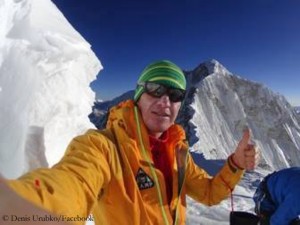

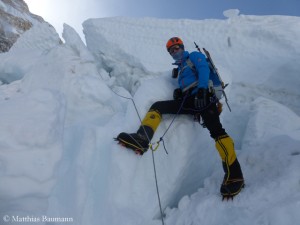
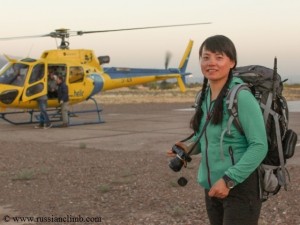
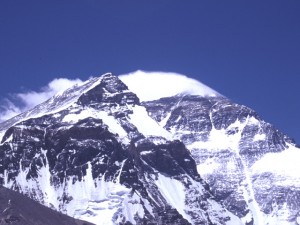
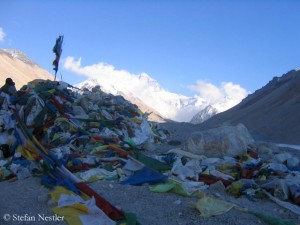

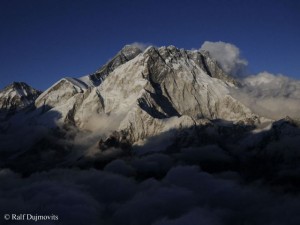
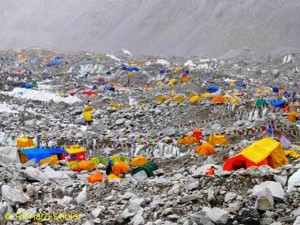
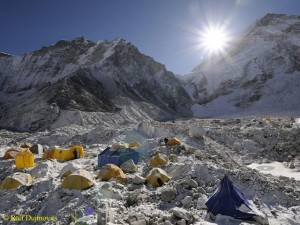
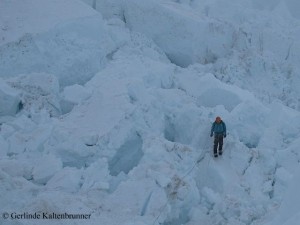
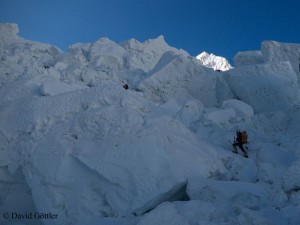
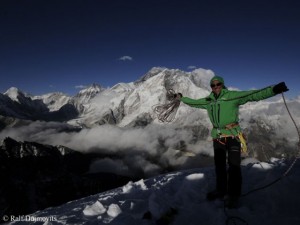
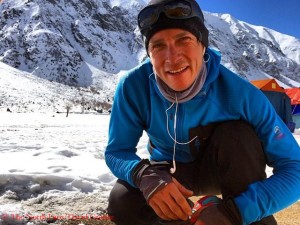





Feedback